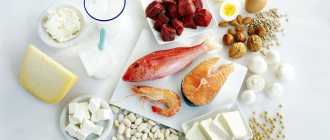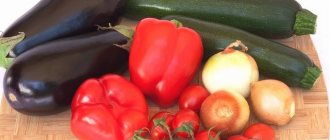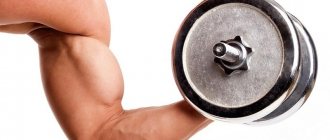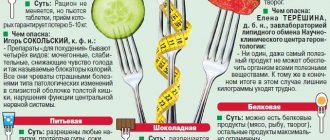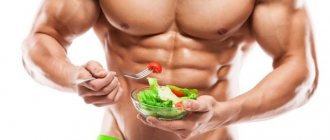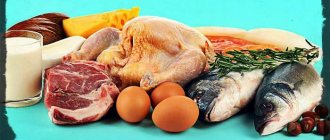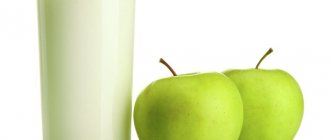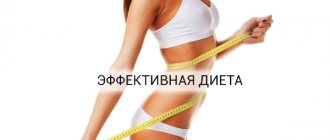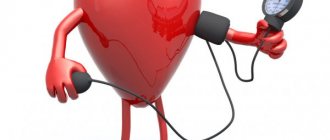A protein diet involves reducing the amount of fat and carbohydrates in the diet, as well as increasing the protein content. Thus, the body has to rebuild its metabolism, breaking down fat deposits.
The effectiveness of such a nutritional system is obvious: up to 4 kg of excess weight is lost in a week, but nutritionists insist: it is categorically impossible to constantly eat according to this scheme, it is fraught with serious health problems.
What can you eat with such a food system, how long to stick to the diet and how to choose the appropriate variety?
The role of proteins for the body
Life without protein is impossible. The importance of proteins for the body lies in the fact that they serve as material for the construction of cells, tissues and organs, the formation of enzymes, most hormones, hemoglobin and other substances that perform essential functions in the body. Proteins and their role in the body is also that they are involved in protecting the body from infections, and also promotes the absorption of vitamins and minerals. Our life activity is associated with the continuous consumption and renewal of protein. To balance these processes, protein losses must be replenished daily. Unlike fats and carbohydrates, it does not accumulate and is not synthesized in the body from other nutrients, that is, you can only get protein with food.
Where to get protein?
Protein consists of small individual “building blocks” - amino acids. Of the 22 amino acids that exist, 9 are considered “essential,” meaning they must be obtained externally because the body cannot produce them on its own.
Animal products are considered “complete proteins” because they contain all the essential amino acids in the optimal amounts that our bodies need. These include eggs, dairy products, meat, fish and poultry.
Plant proteins do not provide the body with sufficient amounts of each essential amino acid, but they can be combined with other plant sources to produce a complete protein. Beans, legumes, grains, soybeans, nuts and seeds are examples of high protein plant foods.
While the quality of protein is important, the quantity we consume is the key factor. With a lack of protein, some types of metabolism may suffer, this is especially noticeable with restrictive low-protein diets.
Pros and cons of a protein diet
In addition to the usual goal of “losing weight,” a protein diet also promotes other beneficial effects for the body. Namely:
- Improved skin condition. Protein is fundamental in the body. Thanks to it, your muscles are strong and your skin does not sag. Increasing the amount of protein in your daily diet will help keep your skin looking great.
- Calorie content. Proteins contain almost 2 times less calories than fats. And given the fact that the body requires much more time and energy to process fats, the process of losing weight is simply inevitable
- Removal of toxins. Protein helps remove excess fluids from the body, and along with them, toxins.
- No feeling of hunger. Due to the characteristics of the body and the long absorption of proteins, the feeling of hunger occurs after a long period of time. And given the fact that the protein diet consists of 4-6 meals, the feeling of hunger does not occur throughout the day.
There are few downsides to a protein diet. Most of them come down to contraindications for certain groups of people. But they cannot be fully classified as disadvantages, because having contraindications to the diet, there is no point in going on it. And if, nevertheless, they sat down, then what is the point of complaining? So, the disadvantages of the diet include:
- Constipation. This is a common problem among people on a protein diet. The solution to this problem is to drink large quantities of water or kefir. If it doesn’t help, then use a laxative
- Decomposition products are not removed. The solution to this problem, as in the previous case, is to drink water in the required quantities.
- Bad breath
- Diet duration. Due to its specific nature, it is not recommended to be on a protein diet for more than a month. If you use a diet only as a means of maintaining a toned figure and are not trying to lose extra pounds, then this restriction does not apply to you.
This is where the disadvantages of the diet end. Everything else already falls into the category of contraindications and should be taken first of all before you go on a diet.
General principles of nutrition
When following a protein diet for weight loss, you need to eat small portions every 3 hours, so the feeling of hunger will not arise. The diet should contain food high in protein, which includes: fish, tofu, dairy products, seafood, and so on. If the menu contains carbohydrate products, then they are allowed only with a low glycemic index.
Cooking Rules
When dieting on proteins, you should adhere to the following food preparation rules:
- To dress salads, use only homemade sauces. It is recommended to replace mayonnaise with soy sauce, and use kefir to season vegetables.
- When preparing vegetable stew, it is important to add spices to it; it is recommended to use the following: ground ginger, oregano and curry. The selected spices should be added in small quantities, as they should be present in the dish only to highlight the taste of the vegetables.
- When cooking meat products, it is recommended to use the following spices as an additive: bay leaf, garlic, sweet peas.
- It is recommended that the fruits included in the diet be raw.
- For drinks use: tea, coffee, freshly squeezed juices, compotes and fruit drinks.
Duration
The duration of the protein diet should not exceed more than two weeks; ideally, it is recommended to adhere to such a diet from 1 week to 10 days. This recommendation is given in order not to create a reload on the liver. The break must be at least 4 months. The 10-day protein diet is the most popular option.
Protein diet rules
Features of the protein diet consist of observing the following rules:
- every meal is protein in combination with other foods;
- All food should be prepared without fat. Your fat allowance per day is 30 grams, which is 1 - 2 tbsp. l. oils as salad dressing;
- until 2 o'clock in the afternoon you are allowed to eat complex carbohydrates in the form of cereals (rice, buckwheat, oatmeal) 4 - 6 tbsp. l.;
- you can use vegetables that do not contain starch (or with a minimal proportion of it) - cucumbers, tomatoes, zucchini, cabbage and lettuce;
- For fruits, give preference to citruses or unsweetened apples (1 – 2 per day);
- drink plenty of water (1 – 2 liters per day);
- You need to eat 4-6 times a day, approximately every 3 hours;
- use herbs, lemon juice, soy sauce, balsamic vinegar, garlic as seasonings;
- do not drink alcohol and sweets during the diet;
- adhere to the table of protein content in foods;
- The duration of the diet is no more than 2 weeks.
Diet for a protein diet
You need to eat at least 5 times a day, with the last time you can afford food 3 hours before bedtime, and breakfast can only begin 30 minutes after you wake up. As for the distribution of nutritional components, before lunch you should consume a small amount of carbohydrates in the form of buckwheat, brown rice or oatmeal. You can also eat some fruit before lunch. You can consume up to 40 grams of fat per day, which is enough for your body.
How to prepare dishes on a protein diet
For 7 days, 14 or a month, the menu, the number of grams per serving, with a protein diet, are not much different.
The first, second and third are an invariable component of breakfast, lunch and dinner. The only difference is in the preparation and time of eating.
The first dish on the menu is soup. The basis of the soup is a protein broth: fish, meat, poultry. Vegetable supplement of choice, cabbage, eggplant, sweet pepper, beans, eggs.
Potatoes are prohibited due to their high carbohydrate content. The lack of pasta and potatoes in the soup will not reduce the taste of vegetable soup with protein broth. Any liquid food contributes to weight loss.
For main courses, there is much more choice of products to satisfy hunger and at the same time lose weight. Any recipes consist of chicken, fish, meat, eggs, cottage cheese, with the addition of vegetables, herbs and spices.
The question is what to replace side dishes with? Potatoes, pasta, and cereals are saturated with carbohydrates and therefore are not suitable for any diet. Vegetable dishes will replace carbohydrate side dishes. Bake, boil, stew, for every housewife's taste. Only spices require caution.
The composition may contain sugar, sweet syrup and some additives that are not advisable to consume. By using a variety of foods during your diet, nutritional deficiencies and feelings of hunger are not noticeable.
Protein-rich foods
As you may have already guessed, you should lean on foods high in protein. The supply of this useful microelement is necessary for the normal development of all body systems and weight loss. To make it easier for you to navigate when coming up with dishes for a protein diet, take note of the list below:
- eggs
- chicken breast
- lean beef
- rabbit
- turkey breast
- milk (can be plant-based, such as soy)
- cottage cheese
- kefir
- greek yogurt
- fish (any kind, especially tuna)
- shrimps
- broccoli
- Brussels sprouts
- oatmeal
- quinoa
- legumes (especially lentils and tofu)
- nuts and seeds (almonds, peanuts, pumpkin seeds, etc.)
Protein diet menu options
Each day's menu consists of five meals, including a sufficient amount of protein foods so that the body does not feel hungry. The diet is quite varied, but consists of the simplest and easiest to prepare dishes.
The diet is designed for a week; if you are overweight, the number of days can be increased to 14 days (2 weeks is the maximum at which you can be on a protein diet).
Menu No. 1 protein diet for a week (7 days)
Compose your diet in such a way that its daily calorie content does not exceed 1000 kcal. Distribute them over 5 meals so that the last one is 3-4 hours before bedtime. In a week you can lose 5-7 kg.
| Day | Eating | Menu for the day |
| 1 day | Breakfast | 3 egg white omelette 1 glass of kefir (low fat) tea or coffee without sugar |
| Late breakfast | 1 cup kefir or yogurt (no additives) | |
| Dinner | 100 gr. boiled chicken with spices and herbs | |
| Afternoon snack | 1 apple or orange | |
| Dinner | 100-150 gr. baked fish with herbs and spices. 1 cup low-fat kefir | |
| Day 2 | Breakfast | 2 hard-boiled eggs, 1 tomato, 1 whole grain bread |
| Late breakfast | 1 cup kefir or yogurt (no additives) | |
| Dinner | 100 gr. steamed meat, tomato and pepper salad - 100 gr. | |
| Afternoon snack | 1 apple or orange | |
| Dinner | 100 gr. canned fish (you can have tuna or sardinella), 100-150 gr. fresh cabbage and cucumber salad, 1 glass of kefir (fat content up to 5%) | |
| Day 3 | Breakfast | Oatmeal with a handful of nuts or dried fruits. Tea or coffee |
| Late breakfast | Sandwich made from whole grain bread and low fat cheese | |
| Dinner | 100 grams of chicken breast, 1/3 cup of brown rice, tomato and pepper salad - 100-150 grams. | |
| Afternoon snack | 1 fruit, any except bananas | |
| Dinner | 100 gr. Steamed fish, 1 cup boiled beans, 1 cup kefir or yogurt | |
| 4 day | Breakfast | 150 g low-fat cottage cheese, Green tea |
| Late breakfast | a handful of nuts - no more than 30 g. | |
| Dinner | Chicken broth with vegetables and chicken breast. 1 whole grain bread | |
| Afternoon snack | 1 apple or orange | |
| Dinner | Oven-baked fish or meat. Salad of fresh vegetables - cabbage, tomatoes and red pepper. | |
| 5 day | Breakfast | Tomato and lettuce salad seasoned with lemon juice |
| Late breakfast | 1 cup kefir or yogurt (no additives) | |
| Dinner | Creamy broccoli soup with pieces of chicken breast. 1 whole grain bread | |
| Afternoon snack | 5 pieces. any dried fruits | |
| Dinner | Cabbage and green pea salad. Breast baked with cheese and tomatoes (hard cheese) | |
| Day 6 | Breakfast | Omelette of 2 eggs and lean ham. Tea or coffee, all without sugar. |
| Late breakfast | 1 fruit, any except bananas | |
| Dinner | 100 gr. steamed fish, 1/3 cup boiled rice. 1 tomato | |
| Afternoon snack | 1 cup kefir or yogurt (no additives) | |
| Dinner | Stew from vegetables and meat - no more than 200 g. Kefir or yogurt | |
| Day 7 | Breakfast | 150 gr. low-fat cottage cheese with dried apricots, Green tea |
| Late breakfast | a handful of nuts - no more than 30 g. | |
| Dinner | 1/3 cup buckwheat (it’s better not to cook it, but pour boiling water over it and leave overnight) and fish or meat of your choice | |
| Afternoon snack | 1 orange | |
| Dinner | 150 grams of meat with lemon and herbs baked in the oven. Mix the juice of half a lemon and the meat seasoning and marinate the meat for 1 to 4 hours. Then bake in the oven for 25-30 minutes |
Menu No. 2 protein diet for a week
Another advantage of a protein diet for very fast weight loss is that you can create a menu at your own discretion. There are no strict rules here. The above option is just an example. Serving size is about 200-250 g.
Day one: Morning, afternoon, evening meals, snacks
| 1 p.p. (breakfast) | Coffee/tea without sweeteners + cottage cheese |
| 2 p.p. (2nd breakfast) | Apple |
| 3 p.p. (lunch) | Boiled chicken breast with baked vegetables |
| 4 p.p. (afternoon snack) | Empty natural yogurt |
| 5 p.p. (dinner) | Steamed fish + vegetable salad |
Day two: Morning, afternoon, evening meals, snacks
| 1 p.p. (breakfast) | Coffee/tea without sweeteners + yogurt |
| 2 p.p. (2nd breakfast) | Orange |
| 3 p.p. (lunch) | Vegetables (baked) + veal (beef) |
| 4 p.p. (afternoon snack) | Kefir |
| 5 p.p. (dinner) | Fish (baked) and vegetables (natural, without heat treatment) |
Day three: Morning, afternoon, evening meals, snacks
| 1 p.p. (breakfast) | Coffee/tea without sweeteners + a couple of eggs |
| 2 p.p. (2nd breakfast) | Grapefruit |
| 3 p.p. (lunch) | Baked turkey thigh + -5 tbsp. brown rice |
| 4 p.p. (afternoon snack) | Cottage cheese |
| 5 p.p. (dinner) | Cabbage salad + boiled veal |
Day four: Morning, afternoon, evening meals, snacks
| 1 p.p. (breakfast) | Kefir + cookies (2 pcs., made from oatmeal, preferably homemade) |
| 2 p.p. (2nd breakfast) | Kiwi (2 pcs) |
| 3 p.p. (lunch) | Chicken with asparagus |
| 4 p.p. (afternoon snack) | Fresh juice |
| 5 p.p. (dinner) | Seafood and vegetables |
Day five: Morning, afternoon, evening meals, snacks
| 1 p.p. (breakfast) | Omelette of 2 steamed eggs + tea or unsweetened coffee |
| 2 p.p. (2nd breakfast) | Apple |
| 3 p.p. (lunch) | Fish with bread |
| 4 p.p. (afternoon snack) | Ryazhenka |
| 5 p.p. (dinner) | Chicken + raw vegetables |
Day six: Morning, afternoon, evening meals, snacks
| 1 p.p. (breakfast) | Cottage cheese + tea or unsweetened coffee |
| 2 p.p. (2nd breakfast) | Orange |
| 3 p.p. (lunch) | Tofu baked with vegetables |
| 4 p.p. (afternoon snack) | Yogurt without additives |
| 5 p.p. (dinner) | Shrimp with asparagus |
Day seven: Morning, afternoon, evening meals, snacks
| 1 p.p. (breakfast) | Cottage cheese + tea or unsweetened coffee |
| 2 p.p. (2nd breakfast) | Apple |
| 3 p.p. (lunch) | Vegetable soup + boiled beef |
| 4 p.p. (afternoon snack) | Kefir + whole grain bread |
| 5 p.p. (dinner) | Steamed fish + vegetable salad |
Protein diet menu for 14 days
Products on the menu can be safely replaced with equivalent ones from the table of permitted ones, and the proposed dishes can be replaced with ones similar in calorie content and composition. The main thing is to follow the rules: eat small meals 5-6 times a day, drink at least 2 liters of liquid a day, and do not consume prohibited foods.
| Breakfast |
|
| Second breakfasts |
|
| Lunches |
|
| Afternoons |
|
| Dinners |
|
The list of allowed foods is so diverse that it will not be difficult to develop a detailed protein diet menu for yourself; there is room for your imagination to run wild. Step-by-step adherence to a protein diet will allow you to gradually and effectively exit the diet.
Protein food: list of products
Based on 100 grams of product / gram of protein
| Boiled veal | 30,7 |
| Boiled chicken | 20 |
| Boiled turkey | 25,3 |
| Boiled rabbit | 24,6 |
| Pink salmon | 22,9 |
| Flounder | 18,3 |
| Pollock | 17,6 |
| Perch | 19,9 |
| Zander | 21,3 |
| Cod | 17,8 |
| Hake | 18,5 |
| Pike | 21,3 |
| Squid (fillet) | 18 |
| Crabs | 18,7 |
| Shrimps | 17,8 |
| Boiled egg white 1 pc. — 25 gr. | 3 |
| Skim milk | 3 |
| Low-fat kefir | 4,3 |
| Yogurt 1.5% | 5 |
| Low-fat cottage cheese | 18 |
| Cheeses: low fat | 25-30 |
| Dumplings with potatoes 2 pcs. | 5,3 |
| Boiled potatoes | 2,4 |
| Boiled brown rice | 2,2 |
| Boiled rice, polished | 2,4 |
| Rye bread | 6,5 |
| Green peas | 5 |
| White cabbage | 1,8 |
| Sweet pepper | 1,3 |
| Greens (parsley, dill, lettuce, sorrel) | 1,5-3,7 |
| Radish | 1,2 |
| Turnip | 1,5 |
| Bananas | 1,5 |
| Cherries | 1,1 |
| Black currant | 1 |
| White fresh | 3,7 |
| Fresh champignons | 4,3 |
| Sauerkraut | 1,8 |
| Dried apricots | 5,2 |
| Raisin | 1,8 |
| Prunes | 2,3 |
| Apples | 2,2 |
| Dates | 2,5 |
| Natural honey | 0,8 |
| Vegetarian borscht, cabbage soup | 1 |
| Potato | 1,4 |
| Pea | 3,4 |
| chicken broth | 0,5 |
| Meat broth | 0,6 |
| Boiled beef | 24 |
| Beef stew | 14,3 |
| Boiled lamb | 22 |
| Stewed liver | 11 |
| Fried beef liver | 22,8 |
| Fried chicken | 26,3 |
| Roasted turkey | 26,2 |
| Red caviar | 31,6 |
| Black granular caviar | 28,6 |
| Pollock caviar | 28,4 |
| Milk 3.2% | 2,8 |
| Full fat kefir | 2,8 |
| Cottage cheese semi-fat | 16,7 |
| Dutch cheese | 26 |
| Kostroma cheese | 25,2 |
| Brynza | 17,9 |
| Sausage smoked cheese | 23 |
| Processed cheeses | 22 |
| Bulb onions | 2 |
| Stewed white cabbage | 2 |
| Cauliflower | 3,1 |
| Fried zucchini | 1,1 |
| Vegetable cabbage rolls | 2 |
| Green peas | 3,1 |
| Tomatoes | 1,1 |
| Green beans | 1,2 |
| Eggplant caviar | 1,7 |
| Zucchini caviar | 2 |
| Wholemeal bread, rye-wheat | 7 |
| Wheat bread made from premium flour | 8,1 |
| Tomato juice | 1 |
| Boiled pork | 22,6 |
| Fried pork | 20 |
| Chopped pork schnitzel | 13,5 |
| Chopped beef cutlets | 14,6 |
| Lamb kebab | 22,9 |
| Lamb chop cutlet | 20 |
| Boiled duck | 19,7 |
| Roast duck | 22,6 |
| Liver pate | 18 |
| Dumplings 4 pcs. | 14,5 |
| Various canned meats | 15-20 |
| Doctor's sausage | 12,8 |
| Milk sausage | 11,7 |
| Krakow sausage | 16,2 |
| Tallinn sausage | 17,1 |
| Cervelat | 24 |
| Beef sausages | 11,4 |
| Pork sausages | 10,1 |
| Milk sausages | 11 |
| Ham | 22,6 |
| Ham | 14,3 |
| Sprat | 17,1 |
| Herring | 17,5 |
| Cod | 26 |
| Mackerel | 23,4 |
| Sturgeon balyk | 20,4 |
| Natural cod liver | 4,2 |
| Sardines in oil | 17,9 |
| Saira | 18,3 |
Where to begin? Here is a list of 5 foods that are most suitable for a protein diet. With a high protein content, these products contain a minimum of fat and carbohydrates.
Chicken breast
The most popular food during a protein diet. One breast contains about 200 g of weight and 40 g of protein, 2 g of fat, 200 kcal. It is simply irreplaceable when losing weight.
Salmon fillets
Dietary product: high protein content and healthy omega-3 fatty acids. 100 g of product contains 20 g of protein, 8 g of fat and 153 kcal.
Beef
Just as healthy as chicken breast, but the fat content is slightly higher than the latter.
In 100 g of beef: 24 g protein, 15 g fat, 228 kcal.
Eggs
The yolk in an egg is quite high in calories. If you eat, say, 5 eggs per serving, we recommend throwing out 2-3 yolks. If you don’t eat them at all, the protein from the egg will be less digestible - the yolk helps digest the protein. 1 egg contains 12.5 g of protein, 11 g of fat, 157 kcal.
Protein shakes
1 glass of protein shake contains about 40 g of protein. In addition, different powders contain a fairly high amount of vitamins: B1, B2, B6, B9, B12, A, C, PP. Potassium and sodium salts, fructose, and sucrose are added to some types of cocktails.
Attention! Not all protein-rich foods can be eaten without restrictions. Many protein foods are also very fatty!
Herring
It has 19 g of protein and 17 g of fat.
Cod liver
4 g protein and 65 g fat.
Recipes for a protein diet
As you know, a protein diet is based on the complete or partial elimination of carbohydrates from your body. The basis of your diet should be white meat, fish, eggs, and dairy products. In more gentle versions of this diet, you are allowed to eat vegetables and nuts. There's not much you can do in a rigid weight loss system. For a week, and sometimes longer, every day you need to eat only boiled eggs, fish and chicken.
As you understand, the following recipes are more suitable for gentle and more varied in terms of permitted products. They are based on protein products, but to improve the taste, some ingredients can be added that are somewhat out of line with the nutritional principles of a strict protein diet.
First meal
Egg cream soup
Ingredients:
- 400 g chicken or turkey breast;
- 300-400 g spinach;
- 2 boiled eggs;
- 150 ml milk;
- spices;
- salt;
- sprig of parsley.
Boil the meat in 2-2.5 liters of water until cooked with bay leaf, peppercorns and Provençal herbs. Remove the meat and cut into cubes. Add chopped spinach to the broth and boil until tender. Pour soup, milk into a blender bowl, place meat and chopped eggs and beat until creamy. Serve immediately, garnished with a sprig of parsley and half a boiled egg.
Nutritious fish soup
- 400 g fillet of any white fish;
- 1 red onion;
- 400 g cauliflower;
- lemon juice;
- pepper;
- salt;
- natural yogurt (optional).
Disassemble the cauliflower, peel it, cut it into small pieces. Cut the fish into large cubes. Chop the onion into thin half rings. Place everything in a saucepan, add water and cook until done. Season with salt and pepper and add lemon juice and a couple of tablespoons of Greek yogurt before serving if desired.
Chicken meatball soup
- 300 g minced chicken;
- 2 squirrels;
- 1 tbsp. bran;
- vegetable broth (from celery or cauliflower with onions);
- 5 stalks of green onions;
- 1 small onion;
- salt and spices.
Mix the minced meat, whites, bran and finely ground onion, form meatballs the size of a small chestnut. Place meatballs, bay leaf, 5 black peppercorns into boiling broth, boil until tender. Before serving, garnish the soup with finely chopped green onions.
What can you eat
If you decide to follow a protein-based diet, you should first familiarize yourself with the list of permitted and prohibited foods in order to create the correct diet in the future.
Protein products
A protein diet involves what you can eat and what you can’t—the list of foods is presented below:
- seafood;
- lean meat;
- vegetables;
- soft and hard cheeses;
- vegetable oil;
- cereals as an additive for soup;
- offal: kidneys, liver, chicken giblets, tongue and others;
- egg white;
- dried fruits;
- low-fat dairy products.
How to choose meat
Lean meat is the main protein content, which is why it should be included in the diet when following this diet. It is recommended to give preference to the following meat products: duck, chicken, lamb, beef and turkey.
You need to exclude the following types of meat products from your diet:
- sausages;
- sausages;
- canned meat;
- pork;
- smoked meat.
Protein drinks
Drink options:
- Mix one tablespoon of any nuts with a spoon of honey and add the resulting mixture to a glass with 200 grams of kefir.
- To prepare, you will need to take 130 grams of low-fat cottage cheese, 1 teaspoon of bran, any fruit and 130 grams of low-fat fermented baked milk.
- Add 2 tablespoons of oatmeal, any fruit, 1 pinch of cinnamon and 150 grams of low-fat cottage cheese to 250 grams of milk.
- The following ingredients will need to be mixed into 150 grams of kefir: cocoa 1 tablespoon, bran 1 tablespoon and 100 grams of low-fat cottage cheese.
Results and reviews after a protein diet
The results before and after the diet are impressive - in just a week you can lose up to 5 kilograms, depending on your initial weight and activity. Since protein foods saturate the body well with energy, it is recommended to combine the diet with training for maximum effect.
As for reviews, they are both positive and negative. The diet did not suit many people - due to a lack of vitamins and microelements, some of those losing weight developed dizziness and weakness. Despite this, every person who went on this diet lost weight.
Proteins in the diet
Proteins are the building material for all cells of the body. In addition to this function, they have a number of others:
- Helps the functioning of the hormonal and immune systems;
- Removes toxins from the body;
- They take part in the absorption of other elements: carbohydrates, fats, vitamins and microelements.
The human body is not capable of producing proteins on its own. Therefore, it is so important to get them from food in sufficient quantities. Proteins can be of animal or plant origin. The largest amount of proteins is found in meat, fish, poultry, seafood, milk and dairy products, eggs, legumes, especially soy.
If a person lacks proteins, then growth slows down, mental activity decreases, immunity decreases and serious, sometimes irreversible, disturbances in the functioning of internal organs occur. Protein deficiency is especially dangerous for children.
Therefore, a balanced and nutritious diet from the first days is so important for a child. In adults, a lack of proteins leads to chronic gastrointestinal diseases, liver and kidney dysfunction. In addition, there is a risk of fractures due to weakening of bone tissue.
Excess protein is also harmful. Too much protein food disrupts digestion and the functioning of the excretory systems.
Proteins are almost completely absorbed and do not accumulate in the body. Therefore, protein foods are often used as the basis for diets. The simplest and most effective is a protein diet.
Contraindications for a protein diet
Before this diet, undergo a mandatory medical examination, because a protein diet is not allowed for everyone and is completely prohibited:
- in case of abnormalities in the functioning of the heart (arrhythmia) and any of its diseases;
- hepatitis and any liver diseases;
- during breastfeeding and pregnancy;
- with kidney dysfunction;
- for joint pain or related diseases;
- for colitis, dysbacteriosis, chronic pancreatitis and a number of other diseases of the digestive system;
- the diet increases the risk of thrombosis and is therefore not recommended in old age;
- for a duration of more than 4 weeks.
All the pros and cons
Like any other power system, it has its pros and cons. With excessive protein consumption and a long-term diet, urolithiasis develops, the kidneys and liver suffer. Protein products contain purines, which can lead to gout and other joint diseases. Brain activity is supported by carbohydrates. Lack of glucose leads to decreased concentration and memory. The nervous system suffers, unmotivated irritation and despondency appear.
Benefits of the diet:
- fast and comfortable weight loss;
- preservation of muscle mass;
- healthy nails and hair.
Contraindications:
- gastritis, ulcer;
- gurgle;
- heart, kidney, liver diseases;
- pregnancy;
- not recommended for people 45+.
Protein Diet Options
Many modern diets are based on the principle of protein nutrition. Let's look at the most popular options.
Protein-carbohydrate diet
Its essence is that protein days alternate with carbohydrate days, that is, on one day you eat exclusively protein foods, on the other you eat complex carbohydrates. This diet option is considered more balanced and can be followed for more than two weeks. Typically, this diet is resorted to after a purely protein diet to consolidate the result.
Atkins diet
Also known as the Hollywood diet, it has become a favorite of many Hollywood stars. The basis of the diet compiled by Dr. Atkins is the consumption of predominantly protein foods; even high-calorie fatty foods are allowed, but carbohydrates are excluded.
Protein diet of Dr. Pierre Dukan
The most popular of the protein diets is the Dukan nutrition system. This is precisely the system of proper nutrition that you need to adhere to for the rest of your life. According to modern nutritionists, the best diet for losing weight will be the one that you can follow comfortably, without suffering from hunger, without falling from weakness and without getting hung up on calorie counting.
Reviews
“The protein diet came in handy for me after finishing breastfeeding. First, I found the “Protein diet for 14 days with menu” food option and began to stick to it in order to lose weight. The extra 5 kilograms I gained during pregnancy were gone in just a week and a half. It was easy to follow the rules, and since I'm a big fan of protein foods, I was just happy that I was able to achieve results without extra effort. After all, I could eat almost everything I like.”
Ekaterina, 25 years old
“During the process of adherence, I realized that a protein diet is not really for me. I could hardly stand it, since I’m not a big fan of poultry meat. Chicken breast in the last days of the diet practically brought tears to my eyes. But still, my efforts were justified, because by the summer I managed to acquire the parameters I wanted.”
Ksenia, 31 years old
“I have a huge number of unsuccessful experiments with diets behind me, which spoiled my health. But when I came across a protein diet, I immediately noticed the difference from the others. It does not require strict restrictions on the amount of food consumed; the main condition is that the basis of the diet should be protein. At the same time, the body received enough energy, and I could live normally without strict restrictions. And by the end of the diet, I was very pleased with the number on the scales, which became 6 kilograms less, and they did not return even after two years.”
Maria, 40 years old
Recommendations for following a protein diet
Considering the disadvantages of this method of losing weight, we have compiled recommendations for you, following which you can minimize the negative consequences for your body and only benefit from the diet:
- First and most importantly, do not get carried away with the diet too much. Remember that moderation is needed in everything: do not exclude carbohydrates and fats from your diet completely. If after a week of dieting you decide to continue losing weight, do not eat this diet for more than a month, and then take a 2-3 month break.
- Since a protein diet for weight loss for 7 days puts a lot of stress on the kidneys, eat more vegetables.
- Eat at least 4 small meals a day.
- The last meal should be no later than 2 hours before bedtime.
- To avoid problems with stool, maintain a water regime - you should drink at least 1.5 liters of clean water per day.
- Do not exceed the daily caloric intake of 1500 kcal.
- Choose quality products! Remember that the quality of food is very important for losing weight.
- If you include eggs in your diet, do not eat more than 4 eggs per day. This is especially true for egg yolk, which consists mainly of fat and increases cholesterol levels.
- Proteins in combination with carbohydrates are absorbed better. When eating boiled chicken breast, add some steamed cauliflower to your plate. But it is better to introduce carbohydrates in the middle of the day, at lunch.
- If your goal is not only to lose weight, but also to gain muscle mass, remember that muscles grow from strength training.
- To avoid nutritional deficiencies, it is recommended to take vitamins while losing weight.
5 / 5 ( 1 voice )
Alarming symptoms and contraindications
But if poor mood, dry mouth and minor digestive problems are considered normal symptoms of a diet, then more serious reactions from the body should still alert you. If you begin to worry about insomnia, serious problems with stool, stomach pain, severe weakness, then the program should be stopped immediately and immediately consult a doctor.
And for people who suffer from the following ailments, a protein diet is generally contraindicated:
- chronic diseases of the kidneys, liver, pancreas,
- various pathologies of the gastrointestinal tract,
- diabetes,
- oncology.
This food system should not be given preference to those who experience increased physical or emotional stress, as well as children under 18 years of age, the elderly, pregnant and lactating women.
